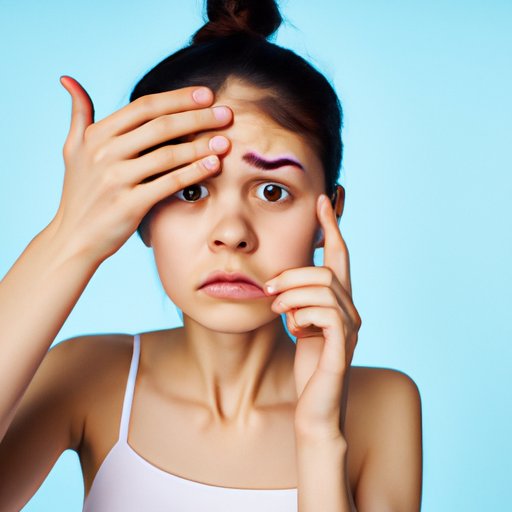Introduction
Acne is a common skin condition that affects people of all ages. It is characterized by red pimples and whiteheads that can range in size from small bumps to large cysts. Acne can occur anywhere on the body, but it is especially common on the face, neck, chest, back, and forehead.
Forehead acne is particularly irritating due to its visible location. It can be embarrassing and can cause self-esteem issues. Fortunately, there are ways to treat forehead acne and prevent it from occurring in the first place. To do this, it is important to understand what causes forehead acne.

The Role of Hormones in Forehead Acne
Hormones play an important role in the development of acne. Hormonal imbalances can cause the sebaceous glands in the skin to produce too much oil. This excess oil can then clog pores and lead to the growth of bacteria, which can cause inflammation and breakouts.
There are several common hormonal causes of forehead acne. These include puberty, pregnancy, menopause, polycystic ovary syndrome (PCOS), and certain medications. Hormonal changes can also be caused by stress, which can aggravate existing acne or even cause new breakouts.
Exploring the Causes of Forehead Acne: Diet and Lifestyle Factors
Diet and lifestyle choices can also play a role in the development of forehead acne. Certain foods can cause inflammation, while others can trigger food allergies or intolerances. Eating a diet high in sugar and processed foods can also contribute to acne. In addition, stress and lack of sleep can make existing acne worse. Excessive sweating can also clog pores and lead to breakouts.

Understanding Forehead Acne: How Genetics and Stress Play a Role
Genetics can also play a role in the development of forehead acne. Some individuals are more prone to developing acne than others due to their genetic makeup. Additionally, stress can cause hormonal imbalances, which can lead to breakouts. Stress can also trigger the release of cortisol, which is a hormone that can exacerbate existing acne.

How to Reduce Forehead Acne with Skin Care Routines
The best way to reduce forehead acne is to develop a good skin care routine. This should include cleansing the skin regularly with a gentle cleanser, avoiding acne-causing products, moisturizing, and exfoliating. It is also important to keep the skin clean and free of dirt and oil.
In addition to a good skin care routine, it is important to avoid harsh scrubbing or picking at acne. This can irritate the skin and make the acne worse.
Treating Forehead Acne: What are Your Options?
If you are suffering from forehead acne, there are several treatment options available. Over-the-counter treatments such as benzoyl peroxide, salicylic acid, and retinoids can help reduce inflammation and clear up breakouts. If these treatments are not effective, prescription medications such as antibiotics and oral contraceptives may be prescribed. Natural remedies such as tea tree oil and aloe vera gel can also be helpful in treating acne.
Conclusion
Acne can be a frustrating and embarrassing condition, especially when it appears on the forehead. While the exact cause of forehead acne is not known, it is thought to be related to hormones, diet, lifestyle choices, genetics, and stress. Fortunately, there are ways to reduce forehead acne with skin care routines and treatments.


